Engagement Ring - In Progress
Setting
Stone
Limited Time! Purchase any Engagement Ring and Receive a $250 Gift Card & Premier VIP Bundle.
We guarantee that every single purchase directly impacts one person's life by giving them access to clean water.
A “Lab Diamond” is just like a Natural Diamond, except instead of growing in the Earth, they grow in a lab. There is no visual difference between high quality Lab Created Diamonds vs Natural Diamonds. They sparkle the same, have the same types of color and clarity (more on small nuances below), and can come in the same sizes and shapes. Likewise, Lab Grown Diamonds are just as hard as Natural Diamonds.
Carbon is the main element in both Natural and Lab Diamonds. The only chemical difference between Lab Diamonds vs Natural Diamonds is that most Natural Diamonds contain tiny amounts of nitrogen, and Lab Diamonds do not. This lack of nitrogen is one way gemologists can identify Lab Created Diamonds vs Natural Diamonds. Laser inscription and unique fluorescence are other identifying features of Lab Grown Diamonds.

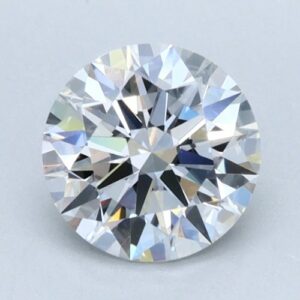
Left: 1.00-carat round natural diamond | Right: 1.10-carat lab diamond.
There are currently two methods of creating Lab Diamonds: high temperature (HPHT) and chemical vapor deposition (CVD).
Chemical Vapor Deposition – or CVD – is the newest method to create lab diamonds. To create a CVD diamond, scientists place a diamond tiny “seed crystal” in a small chamber filled with mineral-rich gas. When the gases are heated, they begin to form layer upon layer of carbon onto the seed crystal. You can imagine this somewhat like a 3D printer! These layers build upon one another to make the diamond grow into a large enough crystal to facet into the diamonds we sell today.
HPHT diamonds have been around for a bit longer, but only recently have we perfected this technology! Previously, HPHT was only used as a “treatment” to “whiten” natural diamonds that were born a less flattering color. Now, diamond scientists create beautiful, bright white lab diamonds from common carbon! To create a HPHT diamond, scientists place natural graphite (like the carbon in your pencil tip!) in a large machine and crushes it with extreme pressure and high temperature. The reason this works is because it mimics how the Earth uses heat and pressure to form Natural Diamonds.
There is no visual difference between high quality CVD and HPHT diamonds. Both technologies can produce beautiful, high end stones which rival natural diamonds. There are small differences which may be noticeable between CVD vs HPHT diamonds when the growth process is rushed, or trace elements find their way into the mix. Notable things to ask your jeweler about (as they do not appear on certificates) include “crystal strain”, “blue nuance”, and brown or mixed “tinge”. Long story short, when looking at a CVD diamond, make sure the stone does not show significant crystal strain – it will make your sparkle less crisp. Blue nuance stones, which occur through the HPHT process, can be desirable in the right conditions. You can read more about these issues here.
No. A Lab Diamond is a real diamond. Because Lab Grown Diamonds have the same chemical and visual properties as Natural Diamonds, the Federal Trade Commission (FTC) even recognized Lab Diamonds as real in 2018.
Cubic Zirconia and Moissanite are diamond “simulants.” This means that although clear in color like a diamond, they are not the same chemical substance as a diamond.
Cubic Zirconia (CZ) is a lab gem that was first made in 1976. There is no such thing as natural CZ. CZ can be completely colorless or a variety of colors. It is flawless. CZ produces more colored light (or “fire”) than diamond does, however it reflects less light in general. Importantly, CZ is nowhere near as hard as diamond. So, over time, CZ often develops unsightly scratches and wear. Diamond, on the other hand, is the hardest substance known to man, and will resist showing wear.
Moissanite can be natural, but it is rare. Instead, scientists create Moissanite for jewelry. At a hardness of 9.25/10, Moissanite is much harder than CZ, but still softer than 10/10 Diamond. Moissanite can be colorless and near colorless. It shows MUCH more colored sparkle (“fire”) than CZ or Diamond. For those looking for an alternative to a Natural Diamond, Moissanite’s hardness and sparkle make it a good engagement stone option to consider, along with Lab Diamonds.
Although there is no difference in appearance between high quality Natural Diamonds vs Lab Diamonds, there are big differences in cost, value, rarity, and sustainability.
There is no difference in look between high quality Lab Diamonds vs Natural Diamonds. Both Natural and Lab Grown Diamonds can be colorless or near colorless. They both can also be a variety of candy colors. Likewise, both Lab Diamonds and Natural Diamonds come in all standard shapes such as round, princess, oval, marquise, pear, cushion, radiant, emerald, and asscher. The sparkle and brilliance of Lab and Natural Diamonds are the same. High Quality stones are identical in look. Lower clarity lab diamonds (those where inclusions are visible to the naked eye) may have different inclusions than their natural counterparts. This is discussed in more detail below.
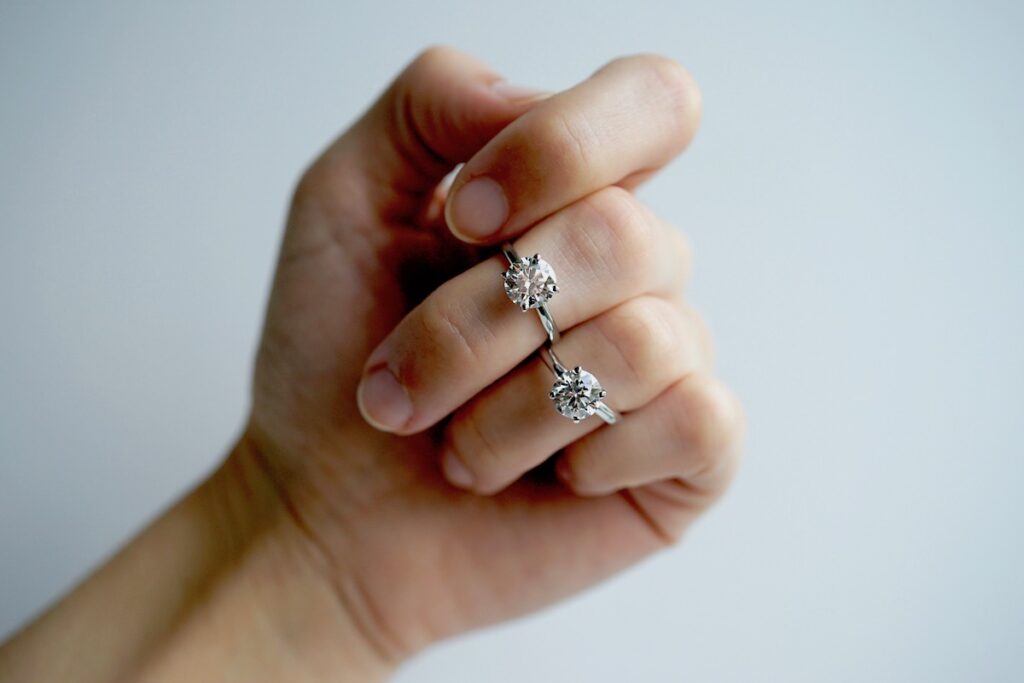
Top: 1.71-carat natural diamond. | Bottom: 1.81-carat lab created diamond.
As you’d expect, Lab Diamonds cost significantly less than Natural Diamonds. This is because we depend upon Mother Nature to create Natural Diamonds, whereas we make our own Lab Diamonds. High quality Lab Grown Diamonds are fairly new. So, Lab Diamond prices have been changing a bit in the last few years. Currently, in a comparison between Lab Diamonds vs Natural Diamonds of similar size, cut, color, and clarity, a Lab Diamond is approximately 10-30% of the price of a Natural Diamond. For example, check these out:
| Type | Shape | Cut | Color | Clarity | Measurements | Cost |
| Natural | Round | Excellent | F | VVS2 | 6.38 x 6.34 x 3.96 | $8,710 |
| Lab | Round | Excellent | F | VVS2 | 6.68 x 6.70 x 4.04 | $1,440 |
Because high quality Lab Diamonds are newcomers to jewelry, and new Lab Diamond brands are launching regularly, the long-term value of Lab Grown Diamonds is not yet settled. That is to say, in the future, technology could advance and Lab Diamond prices could decrease, lowering the value of previously sold Lab Diamonds. Or, on the other hand, as couples learn more about the benefits of Lab Diamonds, demand could rise, increasing values.
With the creation of Lab Diamonds, and the changing needs of millennials, demand for Natural Diamonds has decreased. However, with rising education on diamond grading, and the invention of diamond grading tools like ASET Scopes, the Natural Diamonds purchased today are of much higher quality than ever before. So, high quality Natural Diamond values have stayed fairly consistent.
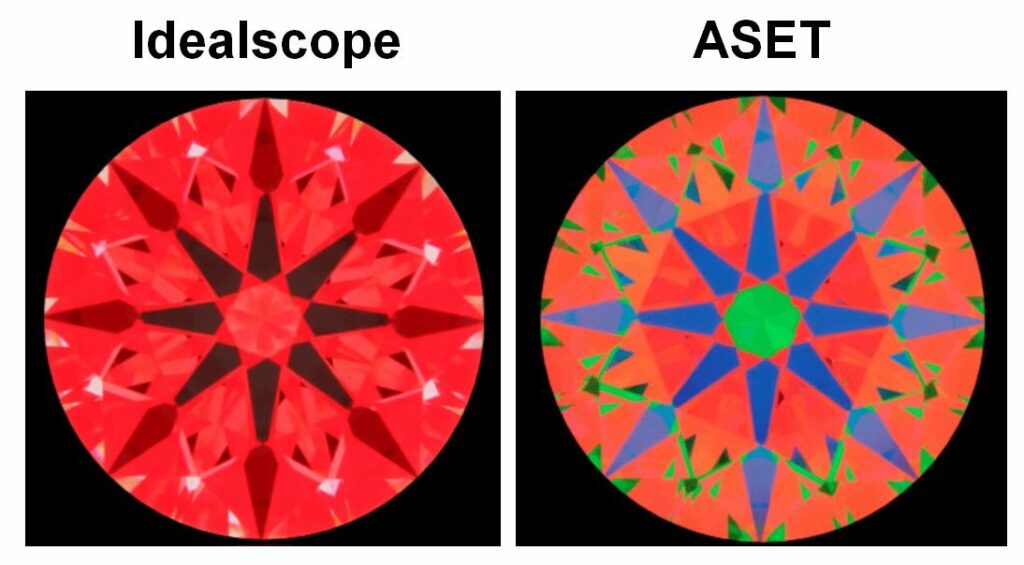
Idealscope VS ASET. (Photo by: YourDiamondTeacher)
Natural Diamond is crystal-clear carbon mined from rock called “kimberlite” deep in the Earth. There is a lot of gossip about the actual rarity of diamonds. This confusion arises from the difference between “gem quality diamonds” and diamonds of lesser quality. True, there are many “industrial-drill-bit-quality” diamonds dug up every day. But we doubt that’s what you want on your finger. In reality, around 100,000 tons of rock has to be dug up and searched through to find a single crystal which could yield a 1.00ct D/Flawless diamond. As you can imagine, moving that much Earth on a regular basis to mine Natural Diamonds is not a very sustainable practice. This is one reason why Do Amore gives back with every diamond purchase.
Creating diamonds in a lab, on the other hand, is much more sustainable. No mining is needed, so the Earth’s crust isn’t disturbed. And, labs are controlled environments, so they are safe and predictable. Finally, many of our lab diamonds are grown using sustainable energy, such as wind, hydro, or solar power!
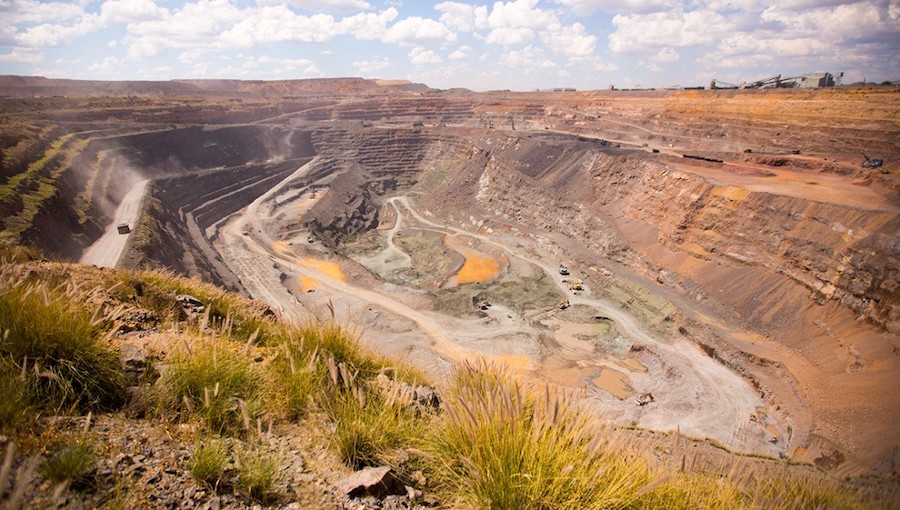
The richest diamond mine in the world, Jwaneng, in Botswana. (Photo by: DeBeers Group)
The buying process for a lab diamond is similar to the process of buying a natural diamond, with a few differences. With natural stones, it is best to choose a GIA certified diamond. With lab diamonds, respected certificates include GIA, GCAL, and IGI. However, when comparing stones, it is important to note that GIA is the strictest grader, and that IGI grades more loosely. Practically, this means that if you are comparing a GIA G color against an IGI F color, they are both likely G color in reality.
Because lab diamonds can have a few more quirks than natural diamonds, and those quirks are not listed on certificates, it is wise to select a reputable jeweler that will be honest with you about the stones they are selling. Be aware that some jewelers have biases towards natural or lab stones. So, if you want to compare both natural and lab diamonds, make sure you choose a jeweler that sells both and is happy to compare and contrast with you! Bonus points if your jeweler of choice is committed to transparency, sustainability, and charitable giving, like Do Amore.
Next, shop for a stone that catches your eye, or ask the jeweler’s gemologist to run a specific search for you within your budget and desired parameters. Make sure the gemologist reviews your stones to rule out any hidden quality issues. In both natural and lab diamonds, this will include shape-specific cut quality, bowtie, and fisheye issues. In lab diamonds, this also includes crystal strain and tinge problems. If your jeweler does not know what crystal strain or mixed tinge is, you should find a new jeweler.
Finally, once you’ve selected your perfect stone, simply match it to the setting of your choice. It is best practice to match lab side stones to a lab center and natural side stones to a natural center!
Have questions on these steps? Reach out to us at care@doamore.com!
Almost all gem labs grade Natural Diamonds on the D-Z color and FL-I3 clarity scales. Many gem labs grade Lab Diamonds differently, however.
As we discussed in our diamond certification post, a GIA Certified diamond has the strictest grading. However, as GIA just recently began grading lab diamonds and does not grade them as frequently, Do Amore additionally recommends GCAL and IGI for your Lab Diamond. Both GCAL and IGI use the same D-Z color scale and FL-I3 clarity scale for Natural and Lab Diamonds. GCAL has a “zero tolerance” grading policy, and is a fairly strict grading lab. IGI was the first lab to grade lab diamonds, and in our experience, has taken the task seriously. While perhaps not quite as strict, they are definitely more well known, and have more extensive experience grading Lab Diamonds. So, couples wanting strict grading should choose a GIA or GCAL Certificate. Couples that desire broad recognition should consider IGI.

An IGI certificate and a GCAL certificate.
The pros of choosing a lab diamond include lower cost, larger sizes, sustainability, and ethical peace of mind. Because lab diamonds are so much less expensive per carat than natural diamonds, couples are able to choose considerably larger stones. This means more bang for your buck! Choosing a diamond that is grown in a lab also means you know that the stone did not require mining tons and tons of Earth, and the people creating the stone were in safe, controlled environments.
The cons of choosing a lab diamond revolve around their newness to market. Because lab diamonds are a relatively new option, pricing has not yet stabilized. So, as compared with natural diamonds, jewelers cannot guarantee what a lab diamond will be worth in the future. In addition, because they are so new, some people feel there is stigma associated with choosing a lab diamond. However, this market is growing exponentially, with younger generations flatly refusing natural stones and opting only to consider lab options. Consequently, we believe the market will continue to grow and thrive.
Not usually! Unlike flawless Cubic Zirconia (CZ) and Moissanite discussed above, Lab Diamonds, just like Natural Diamonds, typically have internal marks that gemologists call “inclusions.” These inclusions are a diamond’s birthmarks. Because Lab Diamonds are also crystal carbon, they have the same types of inclusions as Natural Diamonds, like feathers, clouds, and pinpoints. I am asked sometimes if I can tell real vs lab diamond by a stone’s inclusions. The answer is, sometimes.
Because of the way Lab Diamonds are made, certain Lab Grown Diamonds have small metallic inclusions, flux-like inclusions, or crystal strain that mined diamonds do not. Also, due to the way some lab grown diamonds are laser engraved with their inscription, some lab diamonds also show reflections of their black certification number.

Flux-like Inclusion (Round); Metallic Inclusion (Emerald); Inscription reflection (Pear)
Couples choose Lab Diamonds for a variety of reasons. Cost is king to many newly engaged couples. A big look for less money? Yes, please! As Lab Diamonds vs Natural Diamonds are indistinguishable, many couples feel there’s no reason to pay more money for a natural, mined stone.
Other couples like knowing that their Lab Diamond did not need to be mined from the Earth. This can be due to their preference that the Earth be left in its natural state, or because they want diamonds free from conflict.
Couples concerned about intense mining or questionable ethics may take comfort in knowing the lengths we go to in order to offer only the most sustainable and ethical Natural Diamonds on the market today. Do Amore goes a step further than the Kimberley Process by purchasing only from “Diamond Sightholders,” an elite group of diamond houses recognized for their well-established, outstanding ethical accountability and excellent reputation. We also proudly offer natural Canadian Mark and Recycled Diamonds for those wanting additional reassurances as to the ethics of their Natural Diamond. Click here for more about Do Amore’s commitment to conflict-free diamonds.
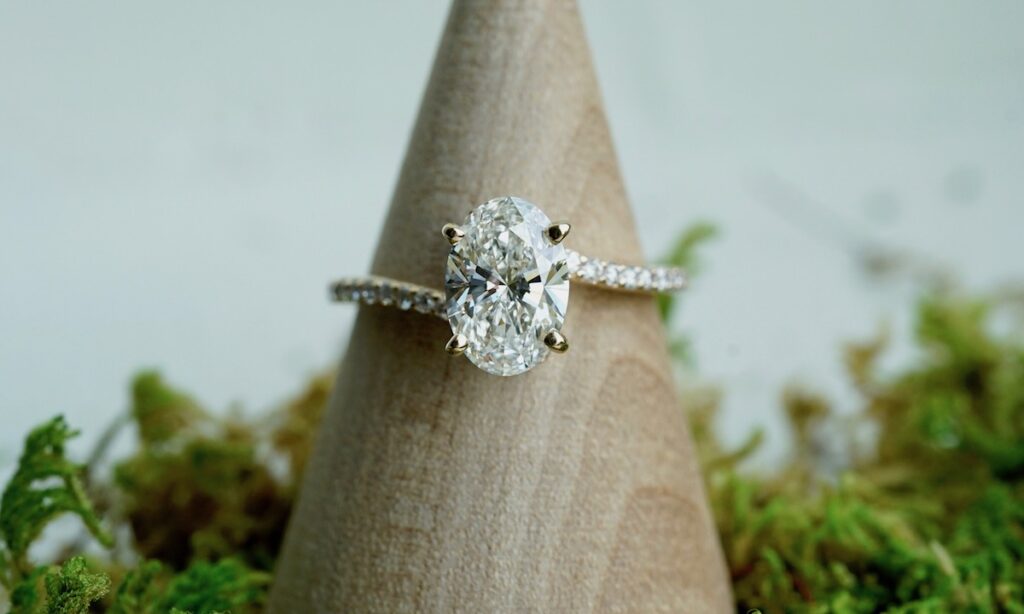
A 2-carat oval lab diamond engagement ring.
Like Lab Grown Diamonds, couples have different reasons for choosing Natural Diamonds. For some, it is a family tradition. Others really enjoy wearing something that is so rare. For many, it is the mystique that the Earth produced this clear, sparkly gemstone. These couples enjoy learning about the nuances of their specific stone, and how it could have formed that way. Finally, some couples feel it is a matter of value, and the consistency in Natural Diamond pricing is a comfort.
Not unless you tell them. There’s no visual difference between Lab Diamonds vs Natural Diamonds to the naked eye. So, can you tell real vs lab diamond? Not without a diamond lab in your back pocket!
Of course! I would love to discuss the benefits of Lab Diamonds vs Natural Diamonds with you and help you pick the perfect stone! Send me an email at care@doamore.com and we can start your Lab Diamond journey today!
Verifiably Ethical & Sustainable
Guaranteed 1:1 Impact
Personalized 1:1 Customer Service
handcrafted & american-made
you before us, always
Verifiably Ethical & Sustainable
Guaranteed 1:1 Impact
Personalized 1:1 Customer Service
handcrafted & american-made
you before us, always
Thoughtfully crafted, made to last, and designed for life's most meaningful moments. LEARN MORE
Diamonds, Gemstones, & Metals
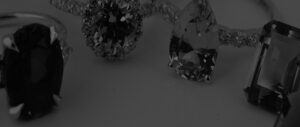
Every piece of Do Amore jewelry begins by not hurting the world. All our natural diamonds are either ethically sourced in Canada, recycled to eliminate additional demand, or accompanied by a blockchain ledger showing every hand your diamond passed through, proving your stone is truly conflict-free.
We also offer sustainable lab-created stones and guarantee all precious metals are recycled to eliminate the environmental impact of mining. Since March 2022, we carry absolutely no Russian diamonds and continue to urge the industry to follow suit.
Clean Water
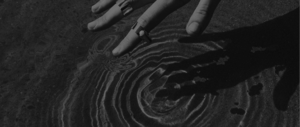
We desire to deepen the well of love in the world. We guarantee that every single purchase—whether engagement ring, wedding band, or piece of jewelry—directly impacts one person’s life by giving them access to clean water.
We do this by directly matching jewelry purchases to people in communities to ensure our funding has a one-to-one impact. We also show you the exact GPS coordinates and a photo of the water well your ring or piece of jewelry helped fund.
Customer Service
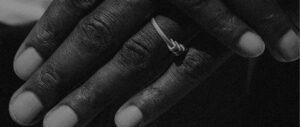
As a small, 100% founder- and employee-owned team, one-to-one encounters are at the heart of our values. Whichever way you want support throughout your engagement ring or jewelry purchase process, our team is here to accommodate you.
From high-touch to hands-off, video calls to text messages, you have our dedicated, responsive team on your side from the moment you start your search, to the day your well is built, to the time we meet again.
Engagement Rings, Bands, & Jewelry
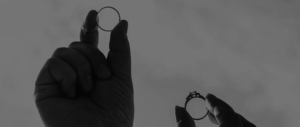
Every Do Amore design, whether one of our own or unique to you, is beautifully handcrafted in America and made specifically for you. Each ring is made to order, every time.
From classic to custom, you have the option to select from dozens of gorgeous settings or work with our design team to create something entirely bespoke. Plus, you are always covered for free inspections, polishing, cleaning, stone tightening, rhodium-plating, and resizing for life.
Our Promise

We care about what matters most to you, not what’s easiest for us. If it’s a minor change to a setting or arriving at a completely custom design, we work to ensure you get precisely what you love.
From statement-making to understated, we have options at any price point. Plus, you always have our team on your side searching to bring you every stone within your specifications. We also offer 60-day returns and a limited lifetime warranty to cover you in the rare event of a manufacturing defect.